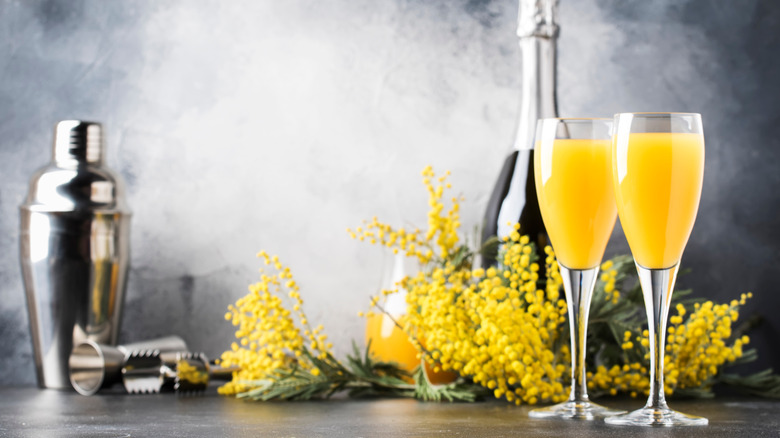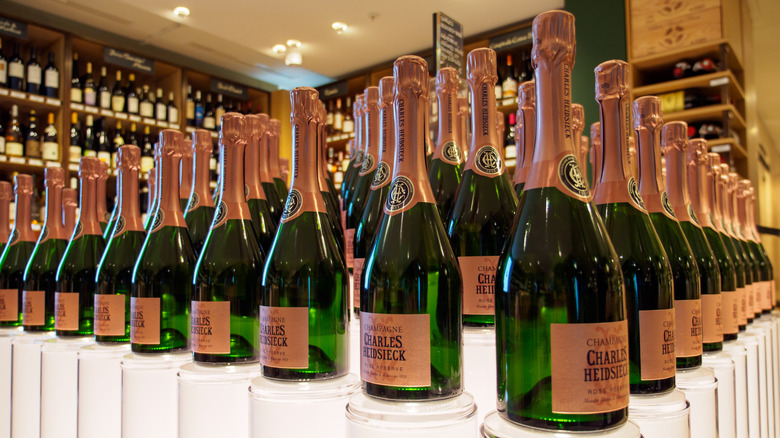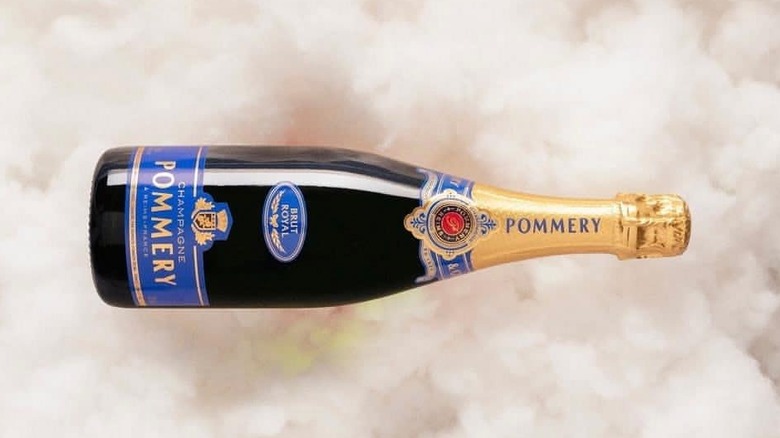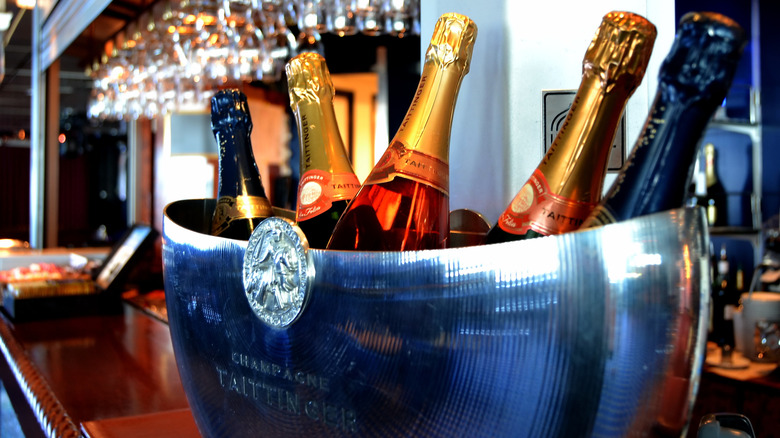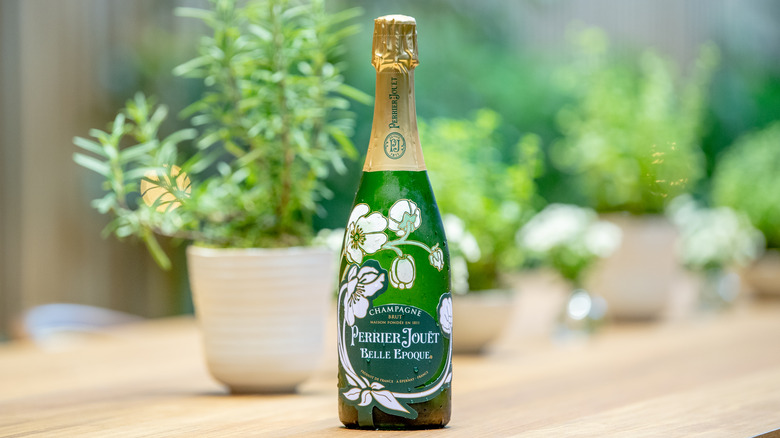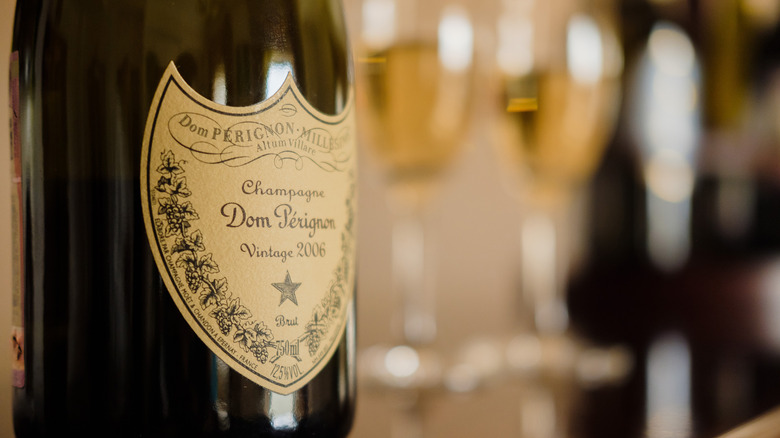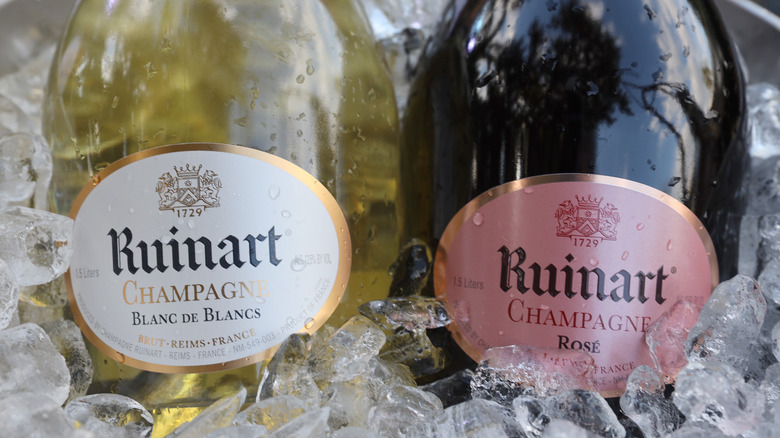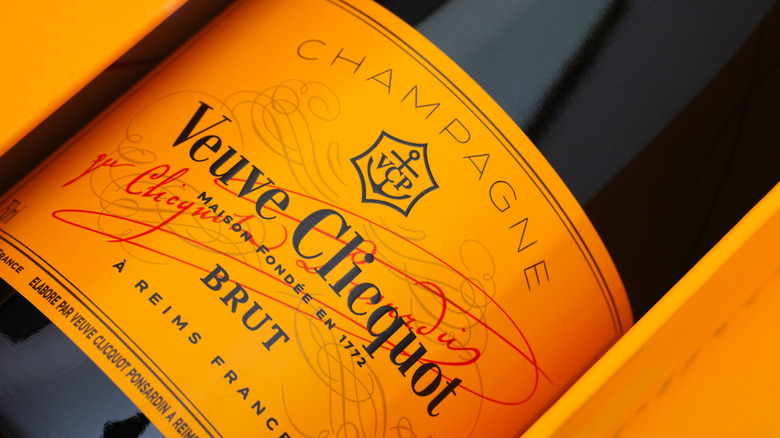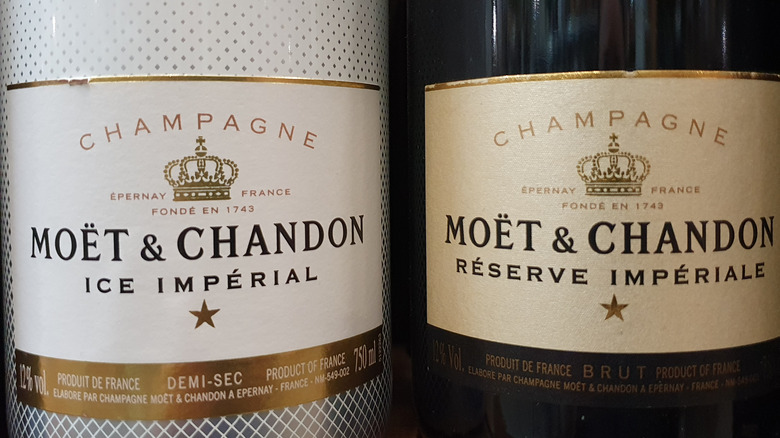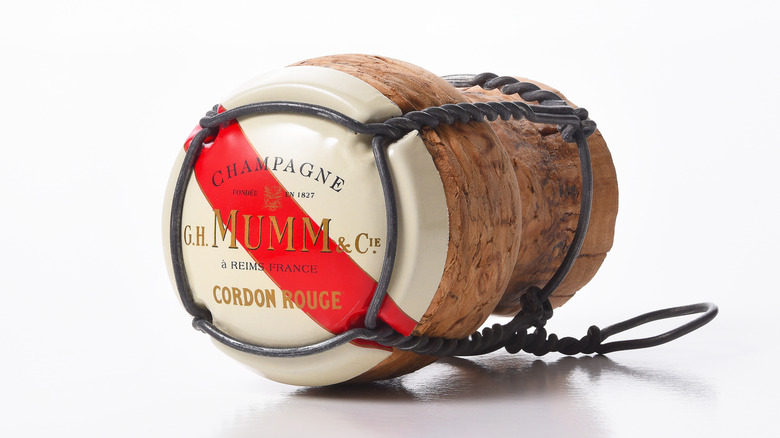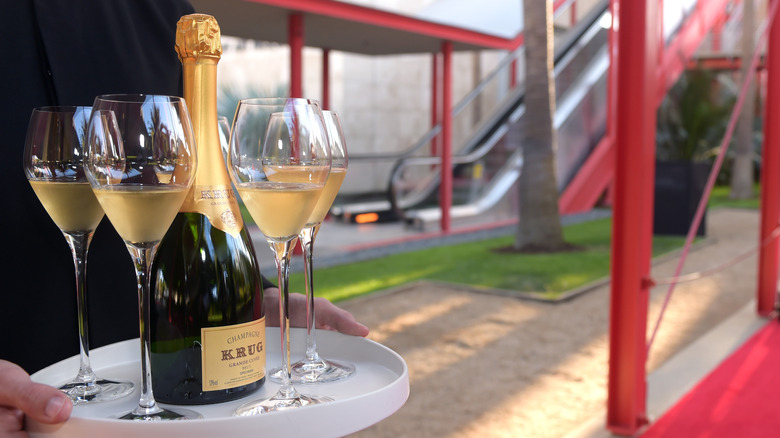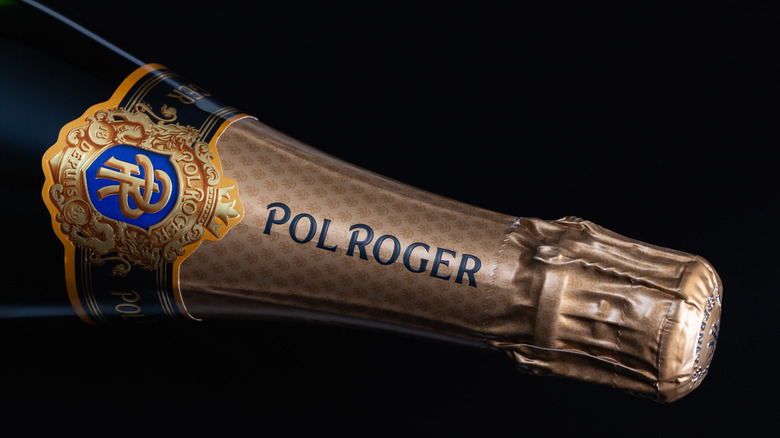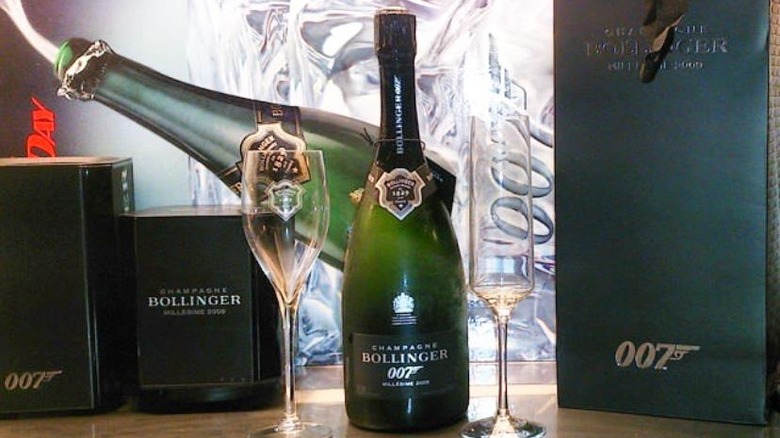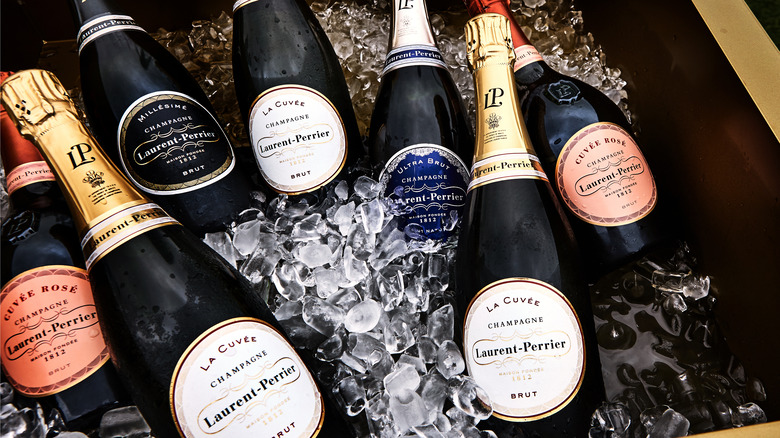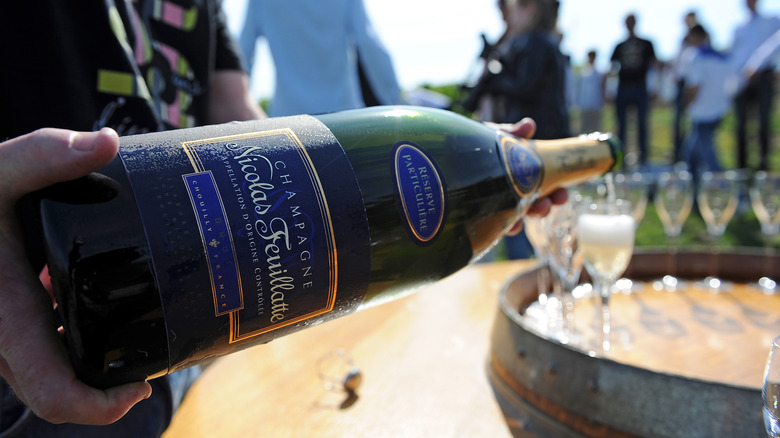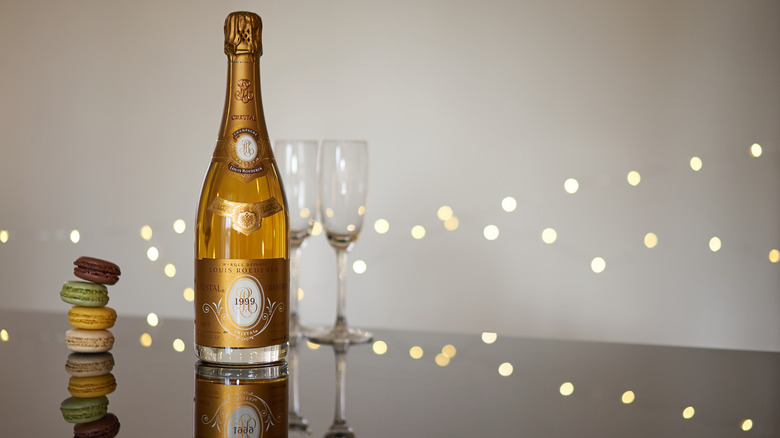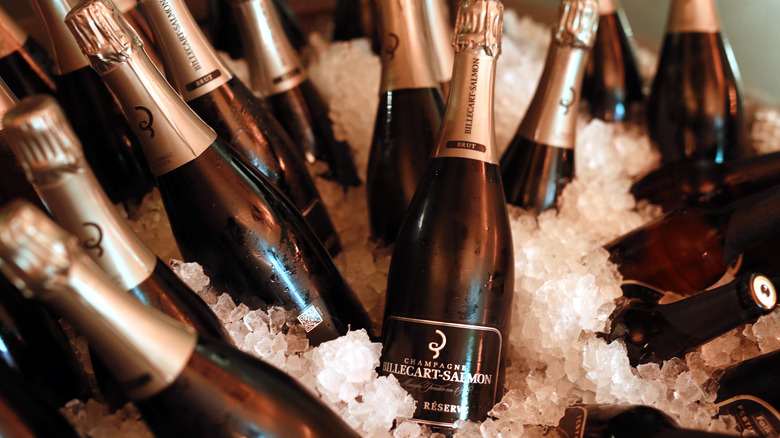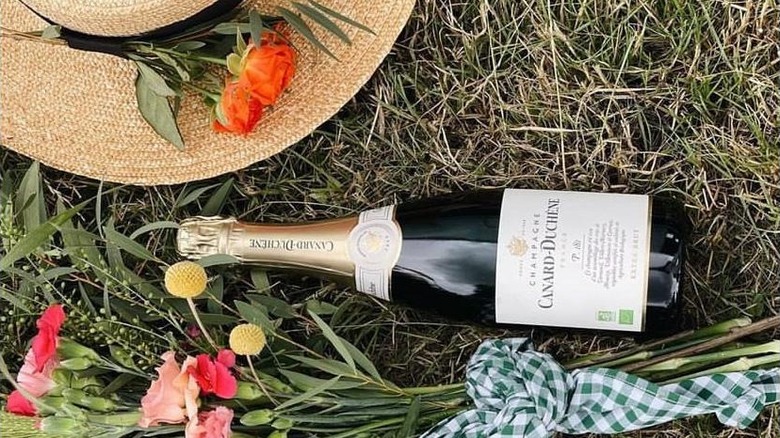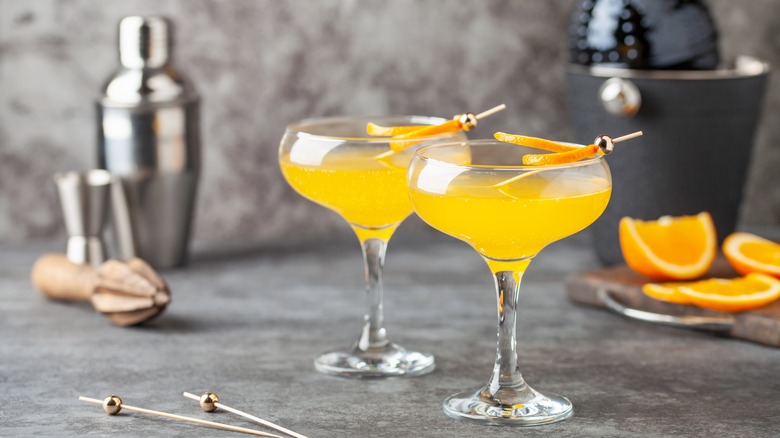The 17 Best Champagnes For Mimosas
Effervescent and crisp, Champagne pairs wonderfully with the tangy sweet flavors of fruit juice. And when it comes to cocktails to try if you like drinking Champagne, the classic mimosa has been a delicious pop of fizz on brunch tables, wedding receptions, and formal celebrations since its inception in the 1920s at The Ritz Hotel in Paris (via Delighted Cooking).
Champagne comes in a variety of types and quality levels, and each house has its signature style and range. While the ways to store Champagne can affect your wine, the true quality of bottles spans three tiers: it starts with simple, non-vintage wines produced with grapes grown over several years to achieve the house style. The next quality level is found in vintage Champagne produced from grapes grown in one calendar year. The top echelon of Champagnes is called prestige or tête de cuvée, which is crafted from the finest grapes produced in only the best years.
In addition to the three-tier quality levels, other factors determine a Champagne's style. It's produced from three grapes — two black grapes (meunier and pinot noir) and one white grape called chardonnay. A Champagne house will blend the grape varieties to achieve its unique individual styles. Vineyard location also affects grape quality, and the best Champagne comes from premier cru and elite grand cru vineyards.
Which Champagne is the best one for your next mimosa? Read on to find out.
Charles Heidsieck Rosé Reserve
Charles Heidsieck, which celebrates its bicentennial in 2022, is a pioneering Champagne brand that's been innovating within the Champagne industry since its inception. The Charles Heidsieck House harvests fruit in eleven unique grand and premier cru regions that produce quality grapes for an entire range of non-vintage, vintage, and prestige cuvée Champagnes. The house produces Charles' style wines (including non-vintage brut and rosé resérve), vintage blanc de blancs, rosé, and brut millésimé. It also produces prestige cuvée blanc des millénaires and two Coteaux Champagnois red wines.
With nine wine styles and multiple vintages available, Charles Heidsieck rosé resérve stands out as the perfect Charles Heidsieck for mimosas. This wine is a blend of 63% pinot noir and 37% chardonnay giving it depth, ripe strawberry and raspberry notes, chalky minerality, and bright acidity that complements the juicy flavors of fresh orange juice.
Champagne Pommery Pop
Legend has it that women made Champagne what it is today. Innovations made by Madame Jeanne Alexandrine Louise Pommery, Veuve Barbe-Nicole Clicquot-Ponsardin, and Rose Adélaide Perrier-Jouët transformed the region into the greatest sparkling wine region in the world.
Madame Pommery transformed her humble vineyards into the first grand marque: a château-style Champagne house and vineyard estate complete with a vast subterranean chalk crayère (caves) for optimal Champagne storage. It was then that Madame Pommery made the unpopular decision to focus primarily on sparkling wine production, leaving more profitable still wines to others. Her gamble is still paying off. She developed the world-famous brut style of Champagne. With high acidity and low residual sugar, palate-pleasing brut Champagne dominates the sparkling wine category (via "Christie's World Encyclopedia of Champagne & Sparkling Wines").
Identified by its bright royal blue label, Champagne Pommery produces a range of non-vintage, vintage, and prestige wines. The brand also cleverly packaged some of its juice in individual serving bottles called Pops. Ideal for mimosas, Pommery Pop comes in three styles: Silver Pop brut, Pink Pop rosé, and Gold Pop vintage Champagne. Pop Champagnes are a blend of meunier, pinot noir, and chardonnay from grand cru vineyards, giving lush and fruity notes with pronounced acidity and lively bubbles.
Champagne Taittinger Nocturne
Champagne Taittinger is one of the three original houses in Champagne and produces a range of exceptional non-vintage, vintage, and prestige wines. Founded in 1743, the house owns some of the oldest and best vineyards in the entire region. Its cellars, located in Place St-Niçaise, are part of a 13th-century abbey (via "Christie's World Encyclopedia of Champagne & Sparkling Wines").
Perhaps most famous for its early advertising campaigns — such as the golden-hued Art Nouveau L'Instant Taittinger poster featuring a sylph Grace Kelly dressed in a taut black evening gown and opera gloves posing suggestively behind a flute of Champagne —the image is a nod to the glamour Taittinger evokes.
Just the name Nocturne conjures up images of an elegant Gatsby-style soirée with glitzy ladies bedecked in jewels sipping Champagne out of vintage cut crystal coupes. Non-vintage Nocturne is crafted from 60% black grapes and 40% chardonnay, giving it bold flavors and aromas along with a pronounced mousse that stands up to orange juice.
Champagne Perrier Jouët
Each bottle of Champagne Perrier Jouët Belle Epoque Fleur de Champagne is a work of art. The Champagne house was founded in 1811 by newlyweds Pierre-Nicolas Perrier and Rose Adélaide Jouët. Still, it was their clever son, Charles, who saw an opportunity to grow the brand by supplying many of the royal and aristocratic courts in Europe with the house juices. That move elevated Perrier-Jouët to a luxury brand long before its main competitors.
With a range of non-vintage, vintage, and prestige wines, Perrier-Jouët is known for its delicate, floral, pale wines that exude elegance (via "The Art of the Vintage"). In 1902, Charles' nephew Henri Gallice crystalized its star power when he hired famed Art Nouveau glass artist Émile Gallé to design a motif for his vintage Champagne bottles. Gallé hand-painted and gilded four magnums with a sprig of white Japanese anemone flowers and deep green leaves with its tendrils wrapping around the bottle. The bottles were discovered decades later, lost to time in the wine cellar, and the design became the iconic logo known today.
The embodiment of luxury, Belle Epoque Fleur de Champagne is available in brut, rosé, and blanc de blancs. The brut is lively and light enough in style, flavor, and aroma to blend perfectly with the fresh orange juice in a truly luxurious mimosa.
Dom Pérignon
Released in 1936 and named for a monk who strove to keep bubbles out of his wines, Dom Pérignon is the quintessential French fizz. Monk Dom Pierre Pérignon resided at the Hautvillers abbey central to the Champagne region (via Millesima). While he was a skilled viticulturist and vintner, Dom Pierre Pérignon actually never said a quote that was famously ascribed to him: "Come quickly, I'm drinking the stars." That was a brilliant marketing campaign devised in 1821 by Dom Groussard, hoping to drive business to the abbey. A century later and on the heels of World War I, Moët & Chandon brazenly released its ultra-luxury cuvée and named it after Dom Pérignon. At the time, the wine was the most expensive Champagne released, doubling that of its closest competitor. The grand cuvée is a robust 50/50 blend of pinot noir and chardonnay (via "Christie's World Encyclopedia of Champagne & Sparkling Wines").
Vintage Dom Pérignon spends 36 months on its lees, giving it depth and warmth with notes of toasted brioche, roasted hazelnuts, and lemon curd, while the rosé exhibits notes of strawberry, raspberry, and peach. Both wines have rich aromatics making each a lovely addition to a mimosa.
Ruinart Blanc de Blancs
Established by Nicholas Ruinart in 1729, Ruinart is the oldest Champagne house. His uncle was Dom Thierry Ruinart, a colleague and close friend of Dom Pérignon (via Millesima). Encouraged by his uncle (and inspired to action by the legalization of bottle sales the year before), Nicholas invited the world to try sparkling wine. Within three generations, Ruinart began gracing royal tables across Europe. A favorite of Empress Josephine and President Andrew Jackson, Ruinart is simply upper-crust ("Sotheby's Encyclopedia of Wine" and "Christie's World Encyclopedia of Champagne & Sparkling Wines"). Ruinart's offer to the world has paid off for generations, as to this day, a large percentage of wine drinkers prefer this sparkling type.
Ruinart produces an ample supply of non-vintage wines along with a blanc de blancs, brut, and rosé. Its vintage and prestige wines can be difficult to locate as few find a way out of Europe. Ruinart's house style is one of chardonnay-dominant sparklers, creating restrained and floral aromatics, bright acidity, and lingering notes of peach and green apple. Try the blanc de blancs as a pairing with orange juice to create a mimosa fit for royalty.
Veuve Clicquot Yellow Label
The Preppy Cookbook suggests that Veuve is the only fizz you need for celebrations and casual sipping. Given the group's penchant for brunch, Veuve Clicquot is also the ultimate mimosa wine. In fact, the author insists on that (via "The Preppy Cookbook").
Clicquot opened its doors in 1772, dealing in textiles and wine. Barbe-Nicole Clicquot-Ponsardin married François Clicquot in 1799, and by 1805 she became a veuve (widow) at the age of 27 when her husband succumbed to tragedy. A formidable woman, Madame Clicquot took on the wine company, and under her deft and clever tutelage, she created one of the first Champagne empires (via Millesima). With an eye for innovation, Barbe-Nicole developed a "riddling" system that slowly clarifies the dead yeast and debris from the murky Champagne resulting in a fresh and lively wine.
Veuve Clicquot produces a range of styles and quality levels. La Grande Dame brut and rosé are tête de cuvée vintage wines crafted in only the best years, exemplifying the great lady who once led one of the most successful Champagne houses of all time. Non-vintage Veuve Clicquot Yellow Label brut has a higher dosage and fruitiness, making it a perfect choice for mimosas.
Moët & Chandon Réserve Impérial
Moët & Chandon was founded in 1743 by Charles Moët, a wine merchant. Over the next several generations, the Champagne house amassed enormous vineyard holdings and a tight relationship with Napoleon elevating the brand to an aristocratic status (via Millesima). The house is one of the largest Champagne producers in France, releasing around 30 million bottles annually. Moët & Chandon aims to produce crowd-pleasing wines that are soft in style with delicate aromas and flavors of shortbread cookies, almonds, and a subtle hint of sweetness found in ripe peaches and apricots. The key to Moët & Chandon's massive success is its production of wines lacking an edge, making the vinos incredibly quaffable. Perfect for every occasion, Moët & Chandon is featured on wine lists the world over and is a favorite wedding wine (via "Christie's World Encyclopedia of Champagne & Sparkling Wines").
Try the Réserve Impérial for your next party. The non-vintage wine is a pinot noir dominant blend with equal measures of chardonnay and meunier. Opt for a pulp-free orange juice so as to not overpower the aromatics of the Champagne.
G.H. Mumm Cordon Rouge
A relative late-comer in the Champagne region, G.H. Mumm was founded by three families in 1827 (via "Sotheby's Encyclopedia of Wine"). Famous for its non-vintage Cordon Rouge and presence on banquet tables the world over, G.H. Mumm is one of the most successful Champagne brands on the market. Easily recognized by the scarlet ribbon emblazing its stark white label, G.H. Mumm is not to be confused with the Napa, California company called Mumm. A traditional Champagne house, the brand produces a range of non-vintage, vintage, and prestige wines but earns its bread and butter with Cordon Rouge.
Cordon Rouge is a lively wine with persistent mousse, lemony citrus and floral notes, and a hint of bitter almond and saline on the finish. What it lacks in complexity, it makes up for in fruit-forward pleasing flavors. Many luxury hotels and restaurants serve Cordon Rouge by the glass, meaning you've likely tried a Cordon Rouge mimosa. For something more substantial, look for G.H. Mumm Millésime, a pinot noir dominant vintage Champagne.
Krug Grande Cuvée
Joseph Krug began his wine career in 1834 at Jacquesson, a Champagne house owned by his wife's family. Krug believed he could produce superior wines, so he struck out on his own and founded Krug Champagne in 1843. True to his vision, Krug remains a luxury Champagne brand. Millesima reveals that his Champagnes have always been associated with the pinnacle of quality. Some modern vintages are considered to be perfection in a glass (via "Christie's World Encyclopedia of Champagne & Sparkling Wines"). The business remained in the family for six generations when, like most brands, it found its way into a luxury brand portfolio. Krug joined LVMH in 1999.
So, what sets Krug Champagne apart? First off, its range starts with prestige-level wines and prices and goes up from there. Krug limits the number of wines released for sale, thus controlling supply and increasing demand. If you come across a bottle or two, savor it.
For the ultimate in elite mimosas, pop the cork on a bottle of Krug Grande Cuvée and blend it with an ounce or two of orange juice — it's just enough to enliven the toasty, nutty, rich wine with tangy citrus fruit flavors.
Champagne Pol Roger Réserve
Pol Roger was only 19 years old when he opened his Champagne house in 1849. He established himself as a top winemaker while working for other houses before he ventured out to make his fortune. His sons, Maurice and Georges, continued his legacy and took the house to the luxury brand level by crafting elegant wines focused on maintaining fragrant floral notes layered with crisp acidity, rich mousse, and a lingering toasty finish (via "Guide to French Wines"). Pol Roger Champagnes are distinguished by lengthy aging times in the coolest chalky limestone caves in the region (via Millesima). The Champagnes were a favorite of Sir Winston Churchill, and in a gesture of honor, Pol Roger's tête de cuvée bears his name to this day (via "Oxford Companion to Wine").
Champagne Pol Roger produces several non-vintage wines, including rich, réserve, and pure — all blended from the three Champagne grapes. Vintage wines include a blanc de blancs, brut, and rosé, with Cuvée Sir Winston Churchill topping the list. Save the Sir Winston Churchill for sipping straight, and make your mimosa with brut réserve or rich. The pure is a bone-dry zero dosage and may be too tart for mimosas.
Bollinger James Bond 007 Champagne
Champagne Bollinger has always been an aristocratic wine. Its founder, Jacques Joseph Placide Bollinger, was of noble birth. In 1829, he partnered with his future father-in-law, Admiral Comte Villermont, and Paul-Joseph Renaudin to form the Champagne house. The majority of Champagne produced at the time was sickly sweet, yet British Champagne aficionados and avid consumers had a taste for dry wines. In 1865, Bollinger began producing demi-sec (slightly sweet) Champagne, soon becoming a favorite of the British (and the official Champagne of Queen Victoria).
It was another great Champagne widow who took the Bollinger Champagne house to the level of prestige and volume that it is today. Widowed at 42, Elizabeth Law "Lily" Bollinger ran the house for 30 years, doubling production while maintaining Bollinger's signature house style by focusing on the pinot noir grape. Millesima reports that the entire range of Champagnes, including one crafted from very old vines, is pinot noir dominant, giving her wines a robust, potent flavor and silky but firm mousse. (via "Oxford Companion to Wine").
Lily created Bollinger RD, a luscious blanc de noirs style with intense aromatics and notes of baked Madeleines, Amaretti cookies, rose petals, freesia, and honeyed apples. A perennial favorite of debonair secret agent James Bond, Bollinger honors each film premiere with a limited edition vintage James Bond 007 Champagne. Have your mimosa stirred, not shaken, to protect the precious bubbles.
Laurent-Perrier Alexandra Rosé
Champagne Laurent-Perrier is one of the oldest firms in the region, opening its doors as Champagne Laurent in 1812. Another widow, Mathilde Émile Perrier, took the helm in 1887 when her young husband, Eugène Laurent, died. Naming her business Veuve Laurent-Perrier, Mathilde kept the petite maison alive. Marie-Louise Nonancourt, who was raised in the legendary Lanson Champagne family, acquired the Champagne house and vineyards upon Mathilde's death. Her son took the operation to the world stage after World War II (via Millesima).
The winery produces a lovely range of non-vintage and vintage Champagnes, including the lusty and lively vintage Alexandra rosé, a pinot noir dominant wine with heady aromatics, ripe flavors, and vigorous mousse. Laurent-Perrier's esteemed grand cuvée, Grand Siècle, is a gorgeous non-vintage wine crafted from the preeminent grand cru reserve juice across three vintages. Master blenders carefully craft the perfect blend before allowing the wine to rest on its lees for seven or more years (via "Christie's World Encyclopedia of Champagne & Sparkling Wines").
According to Robert Parker's Wine Buyer's Guide 7, Laurent-Perrier's non-vintage wines might lack the character that makes its vintage rosé, brut, and Grand Siècle tête de cuvée Champagnes incredible, but that makes this particular selection a great choice for blending with orange juice for mimosas. However, the Alexandra rosé exudes ripe raspberries, strawberries, pink rose petals, gardenia, spice, and toasted hazelnuts, adding depth and flavor to the classic mimosa.
Champagne Nicolas Feuillatte Brut
According to its official website, Champagne Nicholas Feuillatte is the youngest Champagne house. Founder and savvy entrepreneur Nicolas Feuillatte spent his career importing coffee to the United States. In 1976, Feuillatte opened his Champagne house to immediate success by focusing on the American palate. With its fruit-forward fizz, his signature Blue Label Brut has been a mainstay in the U.S. ever since. He sold his brand to Henri Marquet and the Centre-Vinicole de la Champagne cooperative just a decade later. Since then, the Réserve Exclusive Brut Blue Label Champagne and Réserve Exclusive Rosé have gone on to become wildly popular, affordable Champagnes across the globe.
Champagne Nicolas Feuillatte produces an entry-level brut, the two Réserve Exclusives, and a range of vintage wines including several tête de cuvée blanc de blancs, rosé, and super prestige grand cru Champagnes. Feuillatte's Palmes d'Or is a chardonnay delicacy, while its fragrant, elegant Palmes d'Or Rosé is a rare 100% pinot noir Champagne (via "Christie's World Encyclopedia of Champagne & Sparkling Wines"). Stick with the Réserve Exclusive Brut Blue Label for your mimosas. The signature blend of black and white grapes provides classic toasty, biscuit, and peachy Champagne notes to your cocktail.
Louis Roederer Champagne
Christie's World Encyclopedia of Champagne & Sparkling Wines reports that Louis Roederer joined his uncle Nicolas-Henri Schreider in the Champagne business back in 1827. Louis took over and rebranded the house in his name in 1833. Every Champagne house sought royal patrons, and Louis Roederer became a favorite of the wildly wealthy court of Russia. Tsar Alexander I asked Louis' son to create a signature wine exclusive to his court in 1876. That's when Cristal was born. With its sweet, honeyed, fruity notes, the pinot noir dominant wine became a favorite of European aristocracy. Originally bottled in cut crystal, Cristal still comes in a clear-cut glass bottle ceremoniously wrapped in orange cellophane to protect the elixir from light.
According to the official website, Louis Roederer Champagne produces a range of styles, including increasingly sweet, non-vintage brut, extra-dry, sec, and demi-sec styles, along with a vintage range called Millésimé. Cristal and Cristal Rosé are the sultry and luxury tête de cuvée Champagnes from Louis Roederer.
Cristal may be tempting for luxury mimosas, but its sweetness can overpower your cocktail. Save it for sipping and celebrations. Opt for Carte Blanche Extra-Dry, with its hint of sweetness that's reminiscent of Cristal. The wine will complement the pulp-free orange juice in your mimosa.
Champagne Billecart Salmon Rosé
Still a family affair after seven generations, Champagne Billecart Salmon was founded by Nicolas-François Billecart and his wife Elisabeth Salmon (along with her brother Louis) in 1818 (via Millesima). With small vineyard holdings, Billecart-Salmon produces limited quantities of its wines. According to its official website, Billecart-Salmon focuses on extended cold-fermentation giving the wines finesse, creamy aromatics, and delicate flavors. In 1970, Billecart-Salmon introduced its signature wine, a quintessentially French, ultra-pale rosé, to smashing success. Until then, Billecart-Salmon was considered a second-tier Champagne house, but its Brut Rosé brought prestige and attention from critics. So much so that in 1999, the 1959 vintage was named the "Champagne of the Millennium" by a jury of experts following a blind tasting of 150 vintages from the greatest Champagne Houses." That's hefty praise for a Champagne house that had been largely ignored for nearly two centuries.
Christie's World Encyclopedia of Champagne & Sparkling Wines lists a range of six non-vintage Champagnes and six vintage Champagnes including a blanc de blanc, Elisabeth Salmon Rosé, Cuvée Nicolas-François Billecart, Grand Cuvée, and Clos Saint-Hilaire single vineyard vintage Champagne inspired by Krug Champagnes. Try Billecart-Salmon Brut Rosé for your next mimosa celebration. With delightfully subtle floral and fruit aromatics and prominent acidity, the wine pairs beautifully with pulp-free orange juice.
Champagne Canard Duchêne Authentic Green
Victor Canard and Léonie Duchêne founded their Champagne house in 1868 aptly naming it Maison Canard-Duchêne. The house style has always focused on the best expression of pinot noir and remains devoted to the grape for its Champagnes, per its official Champagne Canard Duchêne website.
Canard-Duchêne has never been a showy Champagne house, but it is willing to adapt to the trends of the time. The house style has recently shifted toward fresh, lively, floral wines with bright acidity and fragrant aromatics. The non-vintage and vintage wines are classic blends of the three Champagne grape varietals. Each of the four tête de cuvées blend reserve wines from multiple vintages. Grande Cuvées Charles VII brut and Charles VII rosé are near 50/50 blends of chardonnay and pinot noir, whereas Grande Cuvée Charles VII blanc de blancs is 100% chardonnay and Grande Cuvée Charles VII blanc de noirs is a pinot dominant and meunier blend. In a rare move amongst the top Champagne producers, Canard-Duchêne crafts an exceptional organic wine called Authentic Green Extra Brut Bio. The wine is prone to oxidation due to its limited sulfur dioxide (preservative). Still, it exhibits fresh green apple, lemon zest, and floral notes, making it a lovely choice for mimosas (via "Christie's World Encyclopedia of Champagne & Sparkling Wines").
Cava, Trentodoc, Franciacorta, Cremant
If you are going to deviate from classic Champagne, do yourself a favor and stick to sparkling wines made in the traditional method. According to Wine Spectator, méthode traditionelle, as it is called in France, is a lengthy production process in which bottled wine undergoes a secondary fermentation resulting in the famous fizz Champagne. Nearly every wine-producing country dabbles in different types of sparkling wines, but the best are always traditionally crafted. Some sparkling wines are made exactly like wine soda by adding carbon dioxide to after the wines are finished. These wines have large, fleeting bubbles and can have a slightly bitter aftertaste — just like Coca-Cola or 7-UP.
Look for Spanish Cava, French cremant, Italian franciacorta and Trendodoc, German sekt, and South African cap classique. These wines exhibit many of the same yeasty, toasty, fruity, and floral notes of Champagne at much more reasonable prices. The most promising emerging sparkling wine region is England. The vineyards share the same soil as Champagne, and with our changing climate, the land is becoming warm enough to ripen the classic three Champagne grapes to perfection.
Think about these delicious sparklers when mimosas are called for at your next celebration, wedding, brunch, or a lingering picnic in your favorite park with your loved ones.
